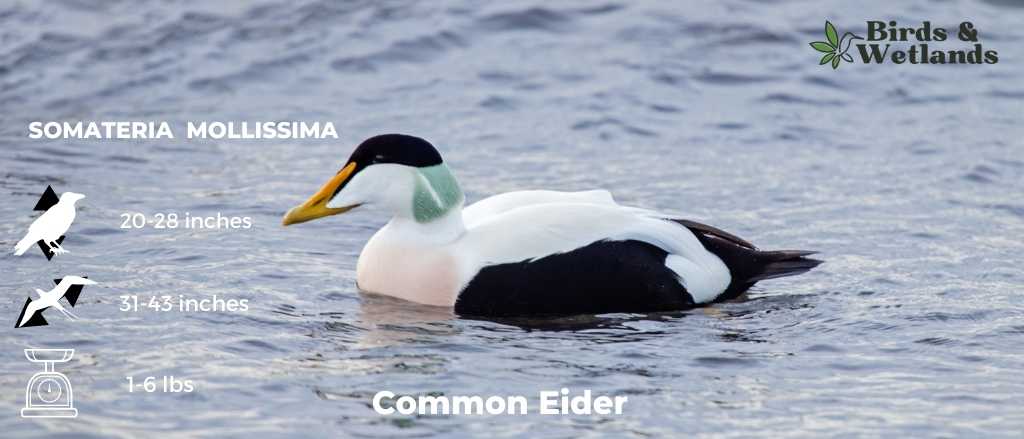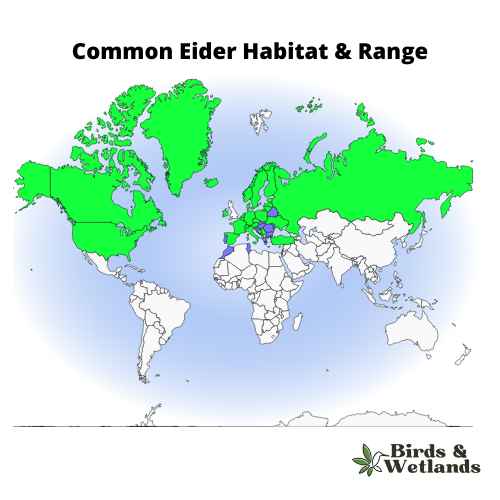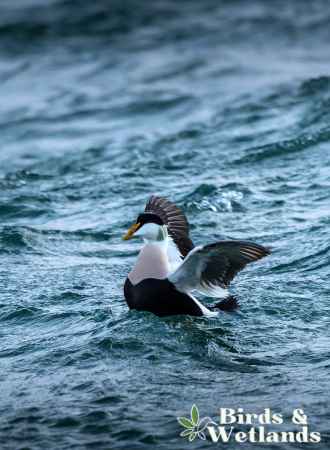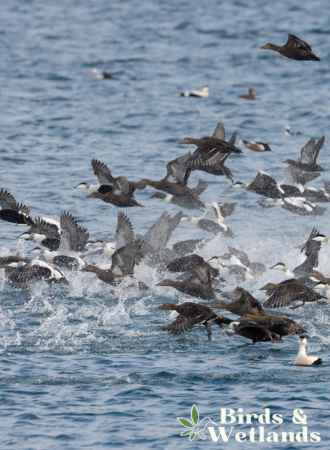
The common eider is a sea duck, also known as the St. Cuthbert’s duck or Cuddy’s duck. It is the largest duck in the Northern Hemisphere.
It has a wide population distribution, with breeding ranges extending across much of the Old World and New World, including parts of the northern coastlines of Europe, Eastern Siberia, and North America. In the winter, the common eider can be found in coastal areas and along the shores of the Atlantic Ocean.
Scientific Name: Somateria mollissima
Length: 50–71 cm or 20–28 in
Wingspan: 80–110 cm (31–43 in)
Average Weight: 0.81 to 3.04 kg (1 lb 12+1⁄2 oz to 6 lb 11 oz)
Taxonomy
The common eider is a member of the genus Somateria, including other eider ducks such as the king eider (Somateria spectabilis) and spectacled eider (Somateria fischeri).
Linnaeus first described the common eider in his Systema Naturae in 1758. It is currently recognized as having several subspecies, including:
- Somateria mollissima v-nigrum – Largest of the subspecies and often described as a separate species from the common eider. Breeding populations occur in the Alaskan Peninsula and Siberia; spend winters in the Aleutian Islands and the Bering Sea.
- Somateria mollissima borealis – breeds in Iceland, Greenland and the northeast region of Canada. Winters in the high Arctic.
- Somateria mollissima sedentaria – commonly found breeding along Cape Cod, Hudson Bay and James Bay coasts.
- Somateria mollissima dresseri – This duck subspecies occurs in the northern North America
- Somateria mollissima faeroeensis – This subspecies is found in the western Palearctic and breeds in the Faroe Islands.
- Somateria mollissima mollissima – This subspecies is found in the western Palearctic and breeds in parts of Europe and Asia, including Iceland, Scotland, and Russia.
Physical Description
Male Common Eiders
An adult male common eider in breeding plumage is a striking bird. Most of its body is white, except for its black wings, rump, uppertail coverts, and tail. The breast of the eider has a pale orange or pinkish wash, and the underparts from the belly to the undertail coverts are also black.
The head of the eider is adorned with a black cap with a white central stripe running along the top and black extending down to the eyes, lores, and sides. It has a hint of light emerald green on the side of its head. It has pale green cheeks.
During the breeding season, the eider exhibits a light greenish area on the rear neck and the back. The bill of the eider is olive-gray and large, wedge-shaped, and its eyes are dark brown. Its legs and webbed feet are pale greyish-blue.

Female Common Eiders
The adult female common eider is a plain brown bird, ranging in color from greyish-brown to reddish-brown. The entire body of the female eider is barred black, and its flight feathers and tail are also blackish.
Adult females and immature males are more subdued version of the adult males, with a more muted color palette and no standout features present in the male during the breeding season.
Despite this, the female eider is still a striking bird in its own right, with its size and head shape.

Listen to the Common Eider
Habitat
The common eider is a species of sea duck that can be found in a variety of habitats throughout the year. During the summer months, it breeds on islands along rocky coasts, estuaries, Arctic tundra, and gravel spits. It also nests in the taiga, often among low-lying krummholz, and uses inland water like pools and streams for nesting.
When temperatures drop in winter, common eiders form large flocks and usually stay close to their aquatic habitat. Some flocks may travel long distances.
It can often be seen along shallow seacoasts or near river mouths with rocky seafloors and strong tides. It is a skilled swimmer that enjoys searching for food in deep water and seeking shelter from harsh weather.
Breeding pairs can be observed close to shorelines during their autumn migration, providing a good opportunity to see these magnificent birds up close.
Range
The common eider is a large sea duck commonly found in the northern hemisphere of the Atlantic Ocean and Arctic seas. It has an extensive range, reaching as far south as Maine in the east and Iceland, Scotland and Norway in the west. The largest breeding population is in Greenland, where it spends its summer months.
During winter, populations disperse to coastal areas around Europe and North America, with some of the more southerly populations traveling as far south as Spain and Morocco.

Feeding Habits & Diet
The common eider is a versatile eater with a varied diet. It feeds on marine invertebrates like mollusks, sea urchins and other crustaceans, and sometimes fish. This bird is skilled at foraging, taking advantage of shallow waters near rocky coasts and islands to dive and catch slow-moving invertebrates with its webbed feet.
The common eider also uses head-dipping and upending to find food. These behaviors are often displayed at low tide, when mollusks are easier to reach, or in the morning or evening when conditions are more favorable.
The common eider has also developed unique behaviors that allow it to access difficult prey by diving deeper into the water column or swimming under rocks and coral reefs. Its ability to find food in many ways helps this sea duck adapt its diet to the resources available in its environment.
Nesting & Mating Habits
The common eider is known for its unique courtship and mating behavior. They typically form mating pairs in late winter or early spring when the male will attempt to attract the female with a series of courtship displays, such as swimming circles around her, raising his feathers, and quacking loudly.
The common eider’s mating season begins in late spring to early summer. They return to their breeding islands from their wintering grounds as soon as the pack ice melts. Breeding pairs create nests near coastal waters, often close to rocky or grassy shorelines with plenty of shelters, food, and water sources nearby.
Common eiders are gregarious birds and often breed in dense colonies, where many pairs of these North American birds gather together in their breeding grounds along one coastline area. The number of ducks breeding together can range from tens to thousands.
The female chooses the nest site, usually on the ground near the water with dense vegetation for cover. It is not uncommon for females to reuse abandoned nests of other waterfowl and gulls.
The nest is a shallowed depression made from soft plant materials and lined with the down feathers of female eiders. Once built, the female will lay between 4 to 5 eggs and incubate them after the second or third egg is laid. The incubation lasts for 25 to 30 days.
During the entire incubation period, the male remains nearby to guard against intruding predators and then leaves once eggs are hatched to molt and feed heavily in unsheltered waters.

Threats & Conservation
The common eider is listed as Least Concern on the IUCN Red List. However, there are still several threats to its survival. Over-harvesting for feathers and eggs, overgrazing by livestock, pollution, and predation by introduced species all threaten the population size.
Predation by mammalian predators such as Arctic foxes also threaten these ducks.
Some populations of common eider have been declared vulnerable in certain regions due to reduced numbers caused by these factors. The Canadian Wildlife Service has spent several years collecting current information on their populations, and preliminary results appear to indicate a population recovery.

Hunting
Hunting common eiders is only legal in the US on a limited basis. The United States Fish and Wildlife Service has allowed for limited hunting of common eiders in areas of Maine, including islands off the Atlantic coast, for subsistence purposes.
Hunters need to be aware that federal and state hunting regulations may prevent them from hunting common eiders in certain areas at certain times according to the rules established by the state and federal governments.

Key Points
- The common eiders breed in the northern hemisphere, including the northern coasts of Europe, Siberia, and North America.
- It belongs to the genus Somateria, which includes other eider species such as the king eider and spectacled eider.
- The nesting site of the common eider is often found on coastal islands and small offshore islands.
- Male common eiders have black and white plumage and a long bill. Female common eiders are brown and barred with black.
- The female builds the nest and lines it with down from her own body.
